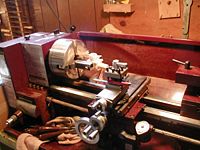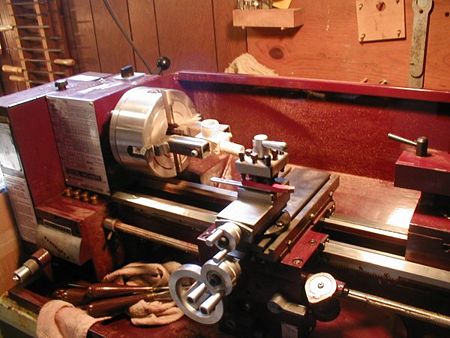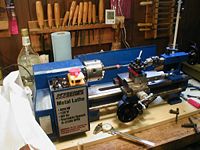Metal Lathe: Difference between revisions
| Line 17: | Line 17: | ||
== Mini metal lathes == | == Mini metal lathes == | ||
=== Chinese made === | === Chinese made === | ||
Like it's larger counter parts, the Chinese made mine-lathes are all made in the same factory. Many are importing them under various names, but aside from length of the bed, color, nameplate, and tooling included, they are all about the same. They work very well once they are carefully cleaned up and re-assembled, sometimes with new hardware. The readily available 7"x12" size seems to be an excellent size for stem work. The 7"x10" can be just a little too short, but it is also possible to get extended beds for many of these lathes. Pictured bellow is the 7"x12" set up for stem work, with a three jaw, self centering chuck that most of them came with, and a Jacobs chuck that comes with some, and is an option with others: | [[Image:9x20.jpg|thumb|450px|left|Mini Metal Lath]][[Image:minilathe.jpg|thumb|left|200px|right|7x20 Metal Lathe]]Like it's larger counter parts, the Chinese made mine-lathes are all made in the same factory. Many are importing them under various names, but aside from length of the bed, color, nameplate, and tooling included, they are all about the same. They work very well once they are carefully cleaned up and re-assembled, sometimes with new hardware. The readily available 7"x12" size seems to be an excellent size for stem work. The 7"x10" can be just a little too short, but it is also possible to get extended beds for many of these lathes. Pictured bellow is the 7"x12" set up for stem work, with a three jaw, self centering chuck that most of them came with, and a Jacobs chuck that comes with some, and is an option with others: | ||
=== The Taig === | === The Taig === | ||
Revision as of 01:01, 7 August 2007
The metal lathe can play a huge role in pipe making. If large enough, it can be used for stummels as well as stems. Many pipe makers have both a metal lathe, and a wood lathe. Others have only one or the other, and still others have multiple metal lathes set up for different procedures. For a complete description of the metal lathe and it's various modes of operation, see the (Wikipedia link).
The main advantage of metal lathes over wood lathes is how precisely they can be used. This precision is achieved through the tool carriage and cross slide, more rigidity, and closer tolerances when manufactured. The tool carriage and cross slide moves the cutting tools precisely, and can maintain nearly any angle relative to the work being cut. This is a huge advantage when cutting tenons for stems, for example.
Full size metal lathes
For the sake of pipe making, I would call any lathe 9"x20" or larger to be full sized. This first number refers to the swing over the bed (or sometimes the tool carriage). This means it is possible for a 9" diameter work piece to swing over the bed, so the actual distance between the chuck center and the bed is actually slightly more than 4.5". The second number is the length of material that will fit between the chuck in the headstock, and the center in the tail stock. Many established pipe makers look for older lathes, such as those made by Atlas, Clausen, some older Sears models (these were all made by Clausen), and South Bend. The UK and the rest of Europe have many fine old lathes kicking around too (a little help here on desirable makes would be appreciated).
For those not yet fortunate enough to find a quality older lathe, the new Chinese made 9" x 20" lathes are an affordable and workable option for many of us. Almost all the Chinese lathes are made in the same factory, and aside from the nameplate of the importer, the finish and accessories included, perform about the same. Popular brands include Jet, Grizzly, and Harbor Freight. While often functional, they all need to be dis-assembled, cleaned and re-assembled with good lubricants, and sometimes improved hardware and bearings.
In addition to being excellent for stems, many pipe makers also use metal lathes for stummel work. The tool carriage and cross slike can be used to rough in stummel shapes, while using it freehand, sort of like the technique used for drawing with an "Etch a Sketch" children's toy. It is also possible to set up a wood lathe style tool rest on a`metal lathe, which allows the use of wood lathe tools to slide along the work. Using a Jacobs chuck in the tail stock allows for very accurate boring of the chamber, mortise, and air hole, as well as facing the shank. A good quality, 9x20 or larger metal lathe, properly set up, can give one all the advantages of the metal lathe as well as most of those of a wood lathe.
The lathe pictured is from Harbor Freight. It has been disassembled, cleaned, and re-fit with improved hardware, and a home brewed chuck, fashioned from a Grizzly 6" 4-jaw independent chuck, and modified after the J.T. Cooke style chuck that several tool makers are making for stummels (this home brewed version works just as well, but sure is not as pretty!). The locating pins allow for precisely positioning the air hole relative to the tobacco chamber. For bent pipes, to sets of locating holes are used. Drill the mortise on the shank bend axis, reposition the block for the air whole, tobacco chamber axis, drill the air hole, then loosen the block slightly, pivot the block on the pins, and re-tighten it to perfectly align the chamber with the air hole.
An excellent resource for information on the Chinese 9"x2" lathes can be found on Yahoo groups. The file sections include entire manuals, as well as through cleaning procedure, and various modifications and improvements: (main discussion site) | Extensive file section spill over
Mini metal lathes
Chinese made
Like it's larger counter parts, the Chinese made mine-lathes are all made in the same factory. Many are importing them under various names, but aside from length of the bed, color, nameplate, and tooling included, they are all about the same. They work very well once they are carefully cleaned up and re-assembled, sometimes with new hardware. The readily available 7"x12" size seems to be an excellent size for stem work. The 7"x10" can be just a little too short, but it is also possible to get extended beds for many of these lathes. Pictured bellow is the 7"x12" set up for stem work, with a three jaw, self centering chuck that most of them came with, and a Jacobs chuck that comes with some, and is an option with others:
The Taig
The basis for the Taig section of this article was written by Tyler Lane for his website, and is used by permission.
I have a Taig, micro metal lathe, and micro it is! For those that are familiar with metal lathes, they would be socked at how small this lathe is. This is it greatest feature and it greatest weakness. Considering the price, this is a wonderful little tool. It is used to turn the tenons on stems to the precise diameter needed for a good fit between stem and stummel. It is also a key tool for doing stem inlay work.
A full-sized, metal lathe is the pipe makers pipe tool. If you have the funds, and want to skip to "the real deal" a nice metal lathe is the tool of choice. Not only can you turn and drill stummels on it, put you can turn the tenons for your stems as well. This is the main tool I would like to upgrade in my shop. A nice, used Atlas metal lathe from the 1950's or so, can be had for about $500 or $600 bucks, and would replace both my Delta Midi Lathe and my Taig.
Many people, like me when I was trying to figure out what tools I needed to start pipe making, do not know the difference between a metal and a wood lathe. The difference is mainly one of precision. I wood lathe has only a bar upon which to rest chisels that you operate by hand to shape the wood. A metal lathe, by contrast, has a tool carriage that precisely move a cutting bit along a constant, though adjustable, diameter. Both a wood lathe and a metal lathe will turn a variety of materials, they simply derive their name from the material that are most often used for.
Coming back to what I use for the precision work needed for turning a good tenon, the Taig, I have put together a listing of all the accessories one needs with the Taig for doing stem work: (prices as of 8/03) If you prefer, you can download this table here as an Excel file.
This is a list of the accessories necessary to equip a Taig lathe to turn pipe stems. Though I have no firsthand experience with them, I have heard that www.cartertools.com is the best place to purchase this lathe and its accessories. (The prices listed below are from that site.)
Part No. Description Price
L1017 Micro Lathe basic unit
(factory assembled) $ 170.65 OR
K1019 unassembled $ 142.50
1021A Motor 1/4HP 1725rpm 1/2"arbor $ 75.00
1022 Motor mount bracket $ 5.00
1023 Mounting board 12"x18" $ 5.50 OR
1024 8"x24"
1060 4-jaw self-centering chuck $ 66.00
1092 Jacob's chuck 1/16"-3/8" $ 9.25
1095 Tool bit set 6 piece $ 25.20 OR
1097A left hand tool bit $ 4.50
1150 Drilling Tail Stock $ 35.50
1151 Needle Bearing Center $ 13.50
1162 Pulley set for 1/2 arbor (specify: belt 500)
$ 22.25 OR
(specify belt 350 if using mounting board 1024)
Total assembled $ 427.85 Total unassembled using alternative parts $ 379.00


